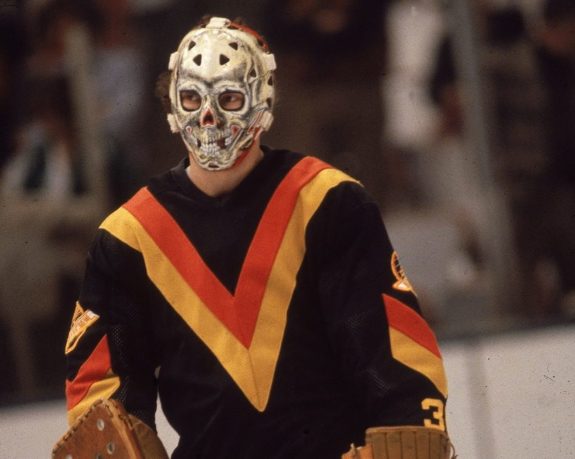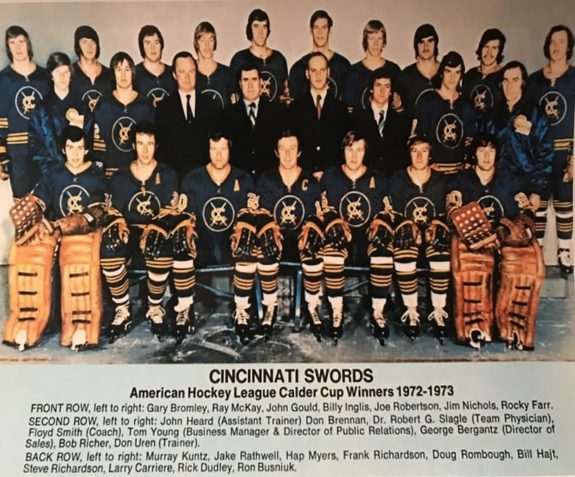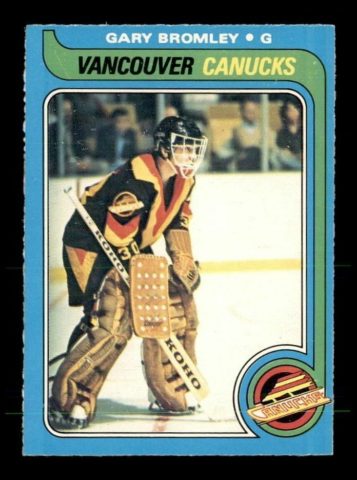There have been many a memorable goalie mask to draw attention in the NHL. Some of them far more iconic than the netminders who donned them, while others were an extension of the goaltender’s persona. 2011 Hockey Hall of Fame inductee and Stanley Cup champion Eddie “The Eagle” Belfour comes to mind in particular, as the masks he wore in his 18 NHL seasons were typically emblazoned with a bald eagle along the sides.
Sign up for our NHL History Substack newsletter
Plenty of other masks stand out too. Brian Hayward’s shark mask in San Jose. Ken Dryden’s bleu, blanc et rouge protector with Montreal. Even Dominik Hasek’s plain and simple caged helmet was so recognizably him.
Other goaltender masks could be given the moniker of “scary” – Gilles Gratton’s lion mask with the Rangers made him look more like a werewolf than anything attributed to an astrological sign. Gratton himself later claimed it was a tiger anyway. Ken Wregget’s “The Penguin” dome plate in Pittsburgh, Gary Simmons’ cobra mask during his days on the West Coast and in Cleveland. So on and so forth.
But hockey’s most chilling mask tends to be overlooked because of its brief existence in the NHL. Not only was Gary Bromley’s skull mask scary, but it was downright unnerving. The way that it was so minutely crafted gave all appearances that standing in the Vancouver Canucks goal crease was a netminder with all of the flesh stripped away from his head. Far more horror than hockey, and almost reminiscent of the occult or folklore.

So who was Gary Bromley – the man behind the skull mask? And why has this frightening protective shield slipped into obscurity?
Bromley’s Road to the NHL
Bromley was born in Edmonton, Alberta, Canada on Jan. 19, 1950. At 5-foot-10 and not even 150 pounds during his professional career, he was as skinny as a rail. Most fittingly, Bromley was bestowed with the nickname of “Bones” due to his slight frame. The moniker would follow him throughout his entire career.
Having gone undrafted after a junior career with the Regina Pats, Bromley signed as a free agent with the Buffalo Sabres on Sept. 29, 1971. The Sabres already had a logjam in net during the 1971-72 professional season, with established veterans Roger Crozier and Dave Dryden manning the nets in Buffalo. Meanwhile, their recently established AHL affiliate the Cincinnati Swords was well-positioned too with goalies Rocky Farr and Ray Reeson already.
Bromley teetered between third-string in Cincinnati and a role with the Eastern Hockey League’s (EHL) Charlotte Checkers. What is important to note as well is that during this same time on Feb. 12 and 13, 1972, the newly christened World Hockey Association (WHA) held its General Player Draft in Anaheim, California. Bromley ended up being selected by the WHA’s New York Raiders, but would not make the jump to the rival league until much later.
Once Bromley got that first season under his belt though, he began to rise up the Sabres’ depth chart. He was a part of the 1972-73 AHL Championship Swords team that won the Calder Cup on Buffalo ice in game five against the Nova Scotia Voyageurs. Bromley served as Farr’s backup during the season, and posted a very decent 19-5-3 record across 31 games. As Farr began to spend more time with the parent club Sabres, Bromley would eventually take over as the Cincinnati starter.

“From a goalie standpoint,” Farr said about his former teammate with the Sabres and the Swords, “with one competing against the other for playing time, ‘Bones’ was the perfect goalie-mate. I say that because the times we played together in Cincinnati and when he played in Buffalo, he was always rooting on the team whether he was playing or not. Because of his unselfishness all of the players liked him, and in the championship Cincinnati season he was a major player in our success that year.”
NHL Emergence in 1973-74
Bromley would play his first NHL game on Oct. 10, 1973. It would be the Sabres first game of the 1973-74 season and they would suffer a 7-4 loss to Toronto on Maple Leaf Gardens ice. Bromley surrendered six goals through the first 40 minutes of play as the Maple Leafs peppered him for 32 shots, and would be pulled for the third period in favor of Crozier.
Not exactly the start that a rookie would want, but he eventually righted the ship. Bromley would earn his first NHL victory in only his third game – a Feb. 17, 1974 showdown at Buffalo’s Memorial Auditorium against the Detroit Red Wings. This time around he was superb between the pipes, as he backstopped the Sabres to a 2-1 win. Bromley stopped 36 of the 37 shots he faced, including all three from eventual Hockey Hall of Famer Marcel Dionne.
Bromley would finish the 1973-74 season having played 12 games. He compiled an overall first-year record of 3-5-3 to go with a 3.31 goals-against average and an .879 save percentage.
Main Goalie During the Cup-Run Season
The Buffalo Sabres would make a run at the Stanley Cup in only their fifth season of existence. The 1974-75 team is still widely considered the greatest team in the franchise’s history. Fueled by the “French Connection” line of Gilbert Perreault, Rick Martin, and Rene Robert, the ’74-’75 Sabres were the first team in NHL history to skate six players with at least 30 goals each. While they would ultimately lose in the Stanley Cup Final to the Philadelphia Flyers in six games, they were a thrilling team to watch.
Perhaps lost in memory banks as the years have gone by, many hockey historians and fans alike forget that it was Bromley who handled the bulk of the goaltending duties in this particular season for Buffalo. In fact, of the four Sabres netminders to see action, only Bromley and Crozier hit double digits for games played.
Bromley played 50 games during the 1974-75 campaign and went 26-11-11. His four shutouts were the most for any Sabres goalie, and tied him with Montreal Canadiens’ great Ken Dryden for the fourth highest total in the NHL. Bromley would also finish eighth in voting among goaltenders to make the First and Second All-Star Teams. It would be the finest and fullest season of his NHL career.
Despite carrying the load among Buffalo goalies during the regular season, Bromley took a backseat come playoff-time. Sabres General Manager Punch Imlach must have felt that he could better his team’s chances of winning the Stanley Cup by acquiring goaltender Gerry Desjardins from the New York Islanders on Feb. 19, 1975.
Bromley would not make any postseason appearances for Buffalo, while Desjardins played the bulk and was backed up by Crozier along the way.
Moving on From Buffalo
The arrival of Desjardins in Buffalo spelled more so the end for Bromley’s time in the “Queen City”. He would make just one appearance during the 1975-76 season, as opposed to Desjardins’ 55 games.
Meanwhile, the WHA’s New York Raiders had relocated to California and had become the San Diego Mariners before the start of the 1974-75 season. Still possessing Bromley’s WHA rights, San Diego traded that entitlement to the Calgary Cowboys in August of 1976.
Seeking a fresh start and the opportunity to be a starting goaltender once more, Bromley jumped to the WHA and joined the Cowboys for the 1976-77 season. Interestingly enough, this Cowboys team included some of his former Buffalo and Cincinnati teammates including Butch Deadmarsh, Paul Terbenche, and Chris Evans. It was also coached by Bromley’s former coach from both teams, Joe Crozier.
Unfortunately for Bromley and his Calgary counterparts, the Cowboys would fold at the end of the 1976-77 WHA season. He would instead sign with the Winnipeg Jets on May 31, 1977. The decision to do so would culminate in ‘Bones’ ultimately winning the most major championship of his professional career.
An Avco Cup With Winnipeg and a Return to the NHL
While it would last for all of one season, Bromley played arguably the finest hockey of his career during the 1977-78 WHA season. He was extremely blessed as well. The Winnipeg Jets were unquestionably the premier team in their own league, and conceivably one of the best in either rival league.
The forward-line trio of Ulf Nilsson, Anders Hedberg and Bobby Hull each scored well over 100 points that season. “The Magic Man” Kent Nilsson was right there with them in his first North American season. Anchoring the rise were effective defenders Lars-Erik Sjoberg, Thommie Bergman, Barry Long, and Stanley Cup champion Ted Green. A heck of a hockey club, indeed.
Bromley split the goaltending duties for Winnipeg with longtime veteran Joe Daley. He finished the 1977-78 season leading the Jets goalies with his record of 25-12-1, a 3.30 GAA and an .886 SV%. Bromley and Daley each appeared in five playoff games for Winnipeg, as they won the Avco Cup by defeating the Birmingham Bulls in five games in the semi-final, before sweeping the New England Whalers in four straight.
In addition to playing for a great team and winning a championship, Bromley’s lone season with Winnipeg rekindled opportunity for him. Demonstrating an ability to win the big game, the Vancouver Canucks would come calling for his services. They would sign Bromley as a free agent on May 23, 1978 – the very next day after the Jets had won the Avco Cup.
Playing for the Canucks

Bromley would play for the Canucks from 1978-79 through the 1980-81 season. Vancouver would make the playoffs in each of his three seasons with the team. In his 73 appearances during that time, Bromley went 25-27-14 for a rather average performance.
In truth, his ‘Bones’ mask may very well be the most remarkable aspect of Bromley’s three seasons in Vancouver.
Part of the problem was that he was involved in a goaltending logjam yet again. The Canucks were in the midst of fostering a rookie goalie in Glen Hanlon who would go on to have a 14-year NHL career. Sprinkle in appearances by Curt Ridley and Dunc Wilson, and Bromley would never really be utilized as a full-fledged starter.
Once the Canucks would bring on “King Richard” Brodeur for the 1980-81 season, ‘Bones’ would become further expendable. Brodeur would end up becoming one of the best goaltenders in Canucks’ history, while Bromley would end up being traded to the Los Angeles Kings on May 12, 1981.
He would never play a game for the Kings, and instead became the starting goaltender of their AHL affiliate, the New Haven Nighthawks. The 1981-82 season would be Bromley’s last in professional hockey.
Bromley’s teammate in New Haven and former Los Angeles Kings forward Warren Holmes remembered the goaltender very fondly.
“I remember Bones as one of the really good guys,” Holmes told THW. ” A term that is likely overused, but in his case it is true. A great teammate and a great goalie.”
Finding the ‘Bones’ Mask
While Bromley’s ‘Bones’ mask may be what defines his time in Vancouver the most, it is somewhat tricky to peg down.
Hockey card collectors waited for many years to acquire a card that depicted the fiberglass skull. Bromley had two hockey cards issued during his time with the Canucks – #167 from the 1979-80 Topps/O-Pee-Chee series and #330 from the 1980-81 O-Pee-Chee series. The 1979-80 card shows Bromley in net wearing a caged helmet, while the 1980-81 one has him donning an all-white, plain fiberglass protector.
It would not be until Between the Pipes issued card #144 for their 2009-10 hockey card series, that anyone could capitalize on owning a collectible depicting Bromley in his mask. Since that time a wider number of hockey cards have been distributed featuring the skull mask.
Playing only 73 games as a Canuck, the two earlier cards made one wonder – “Well, when did ‘Bones’ ever wear his famous mask?’.
Oddly enough, the mask did not come into play until the tail end of his NHL career. Photographic evidence and televised footage show that Bromley did not start utilizing the mask until the 1980-81 season, and only a handful of different photos make the rounds to show it off.
For a mask that is so iconic, it’s existence was very fleeting.
Bromley’s Career Continues on Through His Mask
Bromley’s final NHL game was played on Apr. 4, 1981 against the Calgary Flames. He and the Canucks would lose a close one by the score of 6-5. His former Winnipeg teammate Nilsson beat him for a pair of goals.
Overall, Bromley’s professional career was quite decent. A Calder Cup and an Avco Cup to his credit are noteworthy achievements for any player. Bromley ended the NHL portion of his career with a winning record of 54-44-28 through the 136 games that he played. That includes a 3.44 GAA, .874 SV%, and seven shutouts.
Many years have passed since he last took to the ice. That being the case, many have since forgotten or have never even heard the name Gary Bromley. The two trophies that he won and the two NHL jerseys that he wore fall in with all of the other players who have come and gone. Even the nickname of “Bones” no longer rings a bell.
But Bromley’s mask sticks in the mind’s eye forevermore. Stark, chilling, unnerving – all you need is to see it once, and you do not forget it.
